Read Part I
Striking department store clerks, photo from the Oakland Museum of California.
In the first few days of December 1946, retail workers at Hastings' and Kahn's department stores, across the street from each other where Broadway meets Telegraph, had been on strike for more than a month. Most of the workers were women. Their pay was shitty, less than $16 a week, and worse, they were subjected to an absurd procedure where they had to show up to work first thing in the morning, and then wait in the basement (unpaid), until they were called to the floor to work. A clerk could easily be stuck in the basement all morning, or even all day.
The Teamsters local had supported the retail workers strike from the beginning. They refused to deliver anything to the struck stores. (When I was at the Labor Archives, I even saw minutes from the Teamsters Local 70 meeting showing a member being expelled for trying to deliver to Kahn's in November.) The local NAACP and National Negro Congress publicly supported the striking workers. And union laborers had stopped painting and construction of a new elevator at Kahn's in solidarity.
On the business side, the Oakland Tribune, then run by republican powerhouse Joe Knowland, advocated a citywide ban of pickets. According to Albert Lannon's Fight or Be Slaves, right-wing city council members were publicly objecting to the use of the word 'scab'. Most detrimentally, the city agreed to send out the police force to escort delivery trucks to the stores, so they could keep stock for the Christmas shopping season.
OPD escorting delivery trucks from the notoriously anti-union company G.I. Trucking. From the Oakland Museum of California.
That move was too much for the local labor council. The night of December 1st, a Saturday, Teamsters patrolled every roadway into Oakland to keep the delivery trucks away, and the labor council organized members to use their cars to block the parking spaces surrounding the effected stores. Several hundred picketers came out in the middle of the night to keep the scabs out.
Cops block the street to keep strikers out. From the Oakland Museum of California
At 4 in the morning the cops started towing the strikers cars and blocking off sections of Broadway, Telegraph, and San Pablo. When they waved the streetcars through their police line at 6:30 Sunday morning, a driver told the cops that he'd never crossed a picket line, got out of the car and removed its control box, causing an immovable backup along the streetcar line. The general strike was on, although it was another day before the whole city was out.
Tribune clipping from the Oakland History Room.
At a long and fevered meeting of various local AFL union leaders Sunday afternoon (the clerks were affiliated with the AFL), Teamsters pledged that because of the strikebreaking deliveries, they would shut down work in the East Bay starting Monday. Every other union but the milk truck drivers' agreed, and the milk truck drivers only insisted on working in order to get milk to local hospitals. Labor leaders went on the radio to declare Monday a 'work holiday' and to call everyone downtown, to the center of the strike, to show their support.
From the Oakland Museum of California.
At the peak, as many as 30,000 people were packed into the rainy downtown streets. The mood was excited to say the least. Bars were allowed to stay open, but they were only allowed to serve beer, and were told to turn their jukeboxes out to face the street, where people were literally dancing. All AFL building trades were shut down. All East Bay newspapers were shut down. Buses, streetcars, greyhounds, taxis, and trucking were stopped. Gas stations were closed too. Hotels, movie theaters, and larger restaurants and grocery stores were shut.
The picture's pretty blurry, but can you make out those huge grins? From the Oakland Museum again.
I've read conflicting stories on this, but from what I understand, the CIO, the second-largest umbrella union organization in Oakland, had offered their support the night before the strike. They were patently turned down. AFL leaders didn't want to be associated with the CIO whose on-the-ground organizers were largely communist. Robert Ash, the head of the labor council was quite progressive, but balked at working together, imagining headlines in the paper saying "Reds cause Anarchy Downtown" and so forth. Besides the communist associations, the AFL and CIO were rivals not comrades. Working directly with the CIO would have brought about ugly repercussions from national AFL leadership. The CIO honored picket lines anyway, and finally, on the third day of the strike, called for a general meeting to vote on whether to walk out themselves. A CIO walkout would have cut off gas and electricity to most of the city. At this suggestion, Oakland's city manager was ready to settle.
But the unions had lost the upper hand. The national vice president of the Teamsters, Dave Beck, told the local to withdraw from the general strike. He didn't support revolution, and apparently, the strike was developing that flavor. Rumors circulated that Governor Earl Warren was going to send in the National Guard, and the mayor had declared a state of emergency.
Instead of holding their ground, the union negotiated with Oakland's city manager only for an agreement that police would not be used to break strikes. There was no settlement for the department store clerks (who stayed on strike for eight more months, and then had to settle for a weak contract before they finally negotiated a better deal and a closed union shop in May of '47). There was certainly no attempt to make structural change in the city. Robert Ash from the Labor Council admitted later, in retrospect, that had they held out, they could have had more. Maybe they could have gotten the whole right-wing city leadership to resign.
But even that laudable goal suffers from a failure of imagination. Workers owned the city for those three days. They could have done anything. On the other hand, what can you do when you suddenly control your own world? When you have the power to rearrange everything, if only you can agree with tens of thousands of others who share that power? Who knew what to do with complete worker control of a city?
A year later that kind of question hardly mattered anyway. In 1947, congress passed the Taft-Hartley Act outlawing secondary boycotts (boycotts of union companies that do business with a struck company), removing government protection for wildcat (unofficial) strikers, and allowing the president to force workers back to their jobs if he feels that their strike "imperils the national health". The phenomenon of the General Strike came to an abrupt end.
In the aftermath, the Teamsters local withdrew from the central labor council (and not long after, the national Teamsters withdrew from the AFL). Voters elected a labor slate of candidates for the City Council in '47, but not enough to get a majority, and the winners didn't work very well as a team, and were voted out a few years later. Oakland changed dramatically after the war, demographics changed, the beginnings of civil right struggles emerged, but worker control was not on the agenda.
Found at the Oakland History Room.
If you're interested in the Oakland general strike, I'd recommend Chris Rhomberg's No There There. Online you can listen to a nice KPFA documentary on the strike that features interviews with participants and more on the historical context that led to the strike. Also, check out longshoreman and publisher Stan Weir's account of the strike at the very cool libcom.org or Dick Meister's summery on ZNet.
Subscribe to:
Post Comments (Atom)
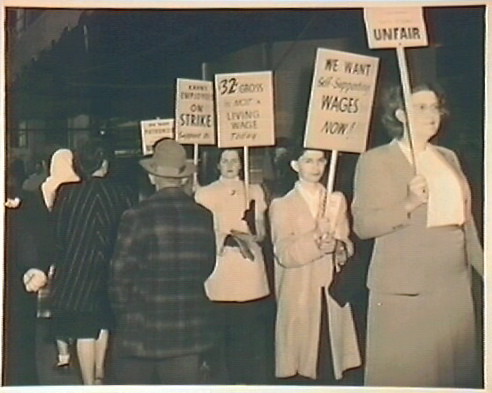
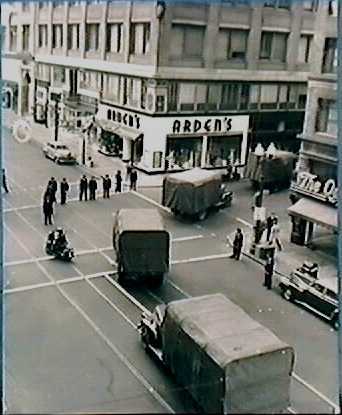
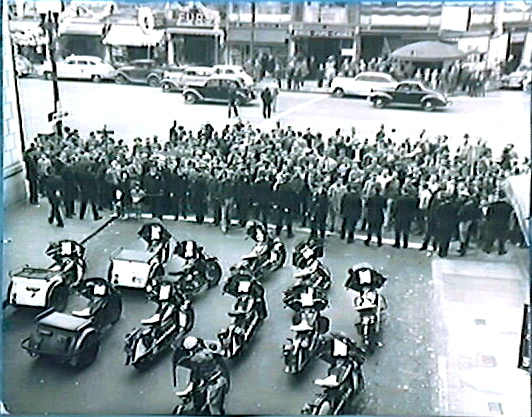
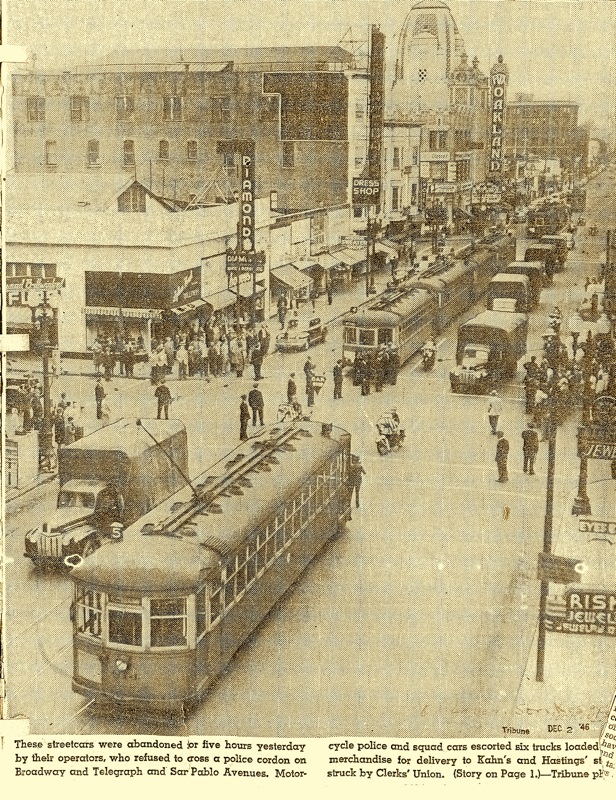
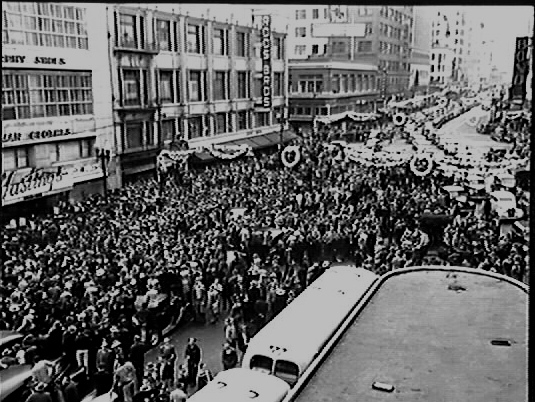

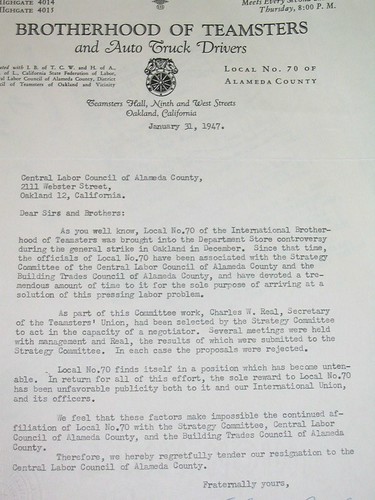

6 comments:
I love the happy white faces and my favorite picture of all is the abandoned trollies and the sand bags. I always think of downtown as abandoned in some ways, but really it is just spread out with random pockets of life. So to think about people coming together in a thriving downtown to protest is cool.
I love that trolly pick too. It's hard to picture that scene in the downtown we have now.
Fascinating!
Fi--I'm finally catching up on reading your blog and I am loving it! I'm so glad you're doing this project.
I was really struck by the story of the streetcar driver who refused to drive over the picket line, and not only left his streetcar in the street but took the control box with him.
Thanks Jo,
I love the thing about the control box too. I guess after a number of hours the city had pressured the streetcar drivers to at least return the cars to their storage barn, but I think they were out there for most of the day.
Just discovered your excellent blog. I just finished a dissertation on the National Negro Congress but left out a half-finished chapter on the Bay Area NNC. If you have any citations for NNC involvement in the Kahn's strike or General strike, would you please send them to: egellman@roosevelt.edu? Thanks in advance.
Post a Comment